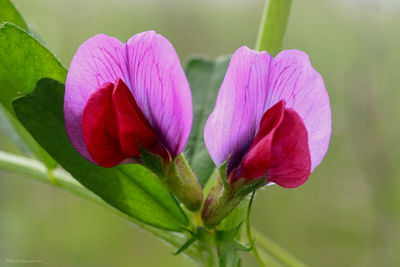Geography and distribution
Common vetch is native to Southern Europe and is now cultivated throughout the Mediterranean, west and Central Asia, China, eastern Asia, India and the USA in many temperate, subtropical and tropical regions.
Description
Overview: Vicia sativa is a scrambling annual herb growing up to 2 metres tall. Its stem is four-angled and sometimes hairy and can be branched, unbranched, climbing or decumbent (trailing along the ground).
Leaves: The leaves are composed of 3-8 pairs of opposite leaflet and a terminal 2-3 branched tendril that assists the climbing habit.
Flowers: The flowers, which are papilionaceous (resembling the garden pea flower) occur in the axils between the leaf stalk and the main stem and are single or in clusters of up to 3. The corolla ranges in colour from white to blue, red to pink-purple.
Fruit: The fruit is a sub-cylindrical pod up to 7 cm long and contains up to 12 seeds. The seeds are round and somewhat laterally flattened and are black to brownish in colour.
Uses
Common vetch is widely cultivated for its high quality forage (fresh, hay and silage) and grain for livestock. It is also a valuable cover crop and is used as green manure.
Crop wild relatives of common vetch
The Millennium Seed Bank and the Global Crop Diversity Trust are engaged in a ten-year project, called 'Adapting Agriculture to Climate Change'. The project aims to protect, collect and prepare the wild relatives of 29 key food crops, including common vetch, so that they are available to pre-breeders for the development of new varieties that are more resilient to the effects of climate change.
Millennium Seed Bank: Seed storage
The Millennium Seed Bank Partnership aims to save plants worldwide, focusing on those plants which are under threat and those which are of most use in the future. Once seeds have been collected they are dried, packaged and stored at -20°C in Kew's Millennium Seed Bank vault.
Description of seeds: Average weight of 1,000 seeds = 38.6 g
Number of seed collections stored in the Millennium Seed Bank: Five
Seed storage behaviour: Orthodox (the seeds of this plant can be dried to low moisture contents without significantly reducing their viability. This means they are suitable for long-term frozen storage)
Germination testing: Successful
This species at Kew
Pressed and dried specimens of common vetch are held in Kew's Herbarium, where they are available to researchers by appointment. Details and images of some of these specimens can be seen online in Kew's Herbarium Catalogue.











